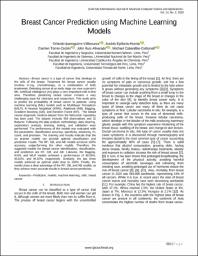Mostrar el registro sencillo del ítem
“Breast Cancer Prediction using Machine Learning Models“
| dc.contributor.author | Iparraguirre-Villanueva, Orlando | |
| dc.contributor.author | Epifanía-Huerta, Andrés | |
| dc.contributor.author | Torres-Ceclén, Carmen | |
| dc.contributor.author | Ruiz-Alvarado, John | |
| dc.contributor.author | Cabanillas-Carbonel, Michael | |
| dc.date.accessioned | 2023-09-20T22:19:30Z | |
| dc.date.available | 2023-09-20T22:19:30Z | |
| dc.date.issued | 2023 | |
| dc.identifier.uri | https://hdl.handle.net/20.500.13053/9404 | |
| dc.description.abstract | Breast cancer is a type of cancer that develops in the cells of the breast. Treatment for breast cancer usually involves X-ray, chemotherapy, or a combination of both treatments. Detecting cancer at an early stage can save a person's life. Artificial intelligence (AI) plays a very important role in this area. Therefore, predicting breast cancer remains a very challenging issue for clinicians and researchers. This work aims to predict the probability of breast cancer in patients. Using machine learning (ML) models such as Multilayer Perceptron (MLP), K-Nearest Neightbot (KNN), AdaBoost (AB), Bagging, Gradient Boosting (GB), and Random Forest (RF). The breast cancer diagnostic medical dataset from the Wisconsin repository has been used. The dataset includes 569 observations and 32 features. Following the data analysis methodology, data cleaning, exploratory analysis, training, testing, and validation were performed. The performance of the models was evaluated with the parameters: classification accuracy, specificity, sensitivity, F1 count, and precision. The training and results indicate that the six trained models can provide optimal classification and prediction results. The RF, GB, and AB models achieved 100% accuracy, outperforming the other models. Therefore, the suggested models for breast cancer identification, classification, and prediction are RF, GB, and AB. Likewise, the Bagging, KNN, and MLP models achieved a performance of 99.56%, 95.82%, and 96.92%, respectively. Similarly, the last three models achieved an optimal yield close to 100%. Finally, the results show a clear advantage of the RF, GB, and AB models, as they achieve more accurate results in breast cancer prediction. | es_PE |
| dc.format | application/msword | es_PE |
| dc.language.iso | eng | es_PE |
| dc.publisher | Science and Information Organization | es_PE |
| dc.rights | info:eu-repo/semantics/openAccess | es_PE |
| dc.rights.uri | https://creativecommons.org/licenses/by/4.0/ | es_PE |
| dc.subject | Prediction; models; machine learning, cells; breast cancer | es_PE |
| dc.title | “Breast Cancer Prediction using Machine Learning Models“ | es_PE |
| dc.type | info:eu-repo/semantics/article | es_PE |
| dc.identifier.doi | 10.14569/IJACSA.2023.0140272 | |
| dc.type.version | info:eu-repo/semantics/publishedVersion | es_PE |
| dc.publisher.country | UK | es_PE |
| dc.subject.ocde | 1.02.00 -- Informática y Ciencias de la Información | es_PE |
Ficheros en el ítem
Este ítem aparece en la(s) siguiente(s) colección(es)
-
Web of Science (WOS) [236]


